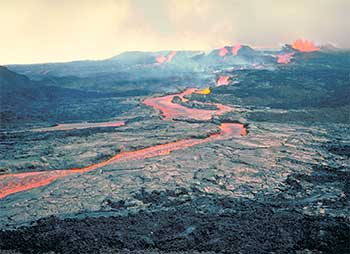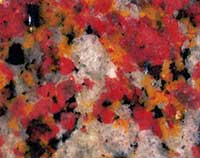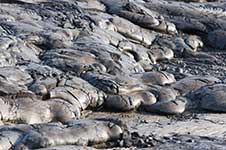| Rocks |
Classification Chart |
Igneous Rocks |
Sedimentary Rocks |
Metamorphic Rocks |
Rock Property Tests |
| Types of Igneous Rocks |
| Types of Igneous Rocks |
 |
| Igneous rock is in the making as lava pours down a well-developed lava channel near a series of erupting vents on the northeast rift zone of Mauna Loa Volcano. |
Igneous rocks
The term igneous comes from the Latin ignis, meaning "fire". Igneous is used to describe rocks that crystallize out of hot molten material in the Earth called magma. When magma pushes up through Earth's crust to the surface, it is called lava. Both magma and lava cool and harden to form igneous rocks.
Intrusive vs. Extrusive
Igneous rocks can be classified into two main categories: intrusive and extrusive. A trick to help kids remember intrusive and extrusive is to think of intrusive -- inside and extrusive -- exit.
 |
| Granite. |
 |
| Pahoehoe Lava Field, Hawaii. |
Texture
Within the two main categories of intrusive and extrusive, rock can be classified even further using texture and chemical composition. The word "texture" has nothing to do with how the rock feels. Texture, in geology, is used to describe how the rock looks. The most noticeable textural feature of igneous rocks is grain size. Grain size refers to the size of the individual mineral crystals. As mentioned above, intrusive igneous rocks, such as granite have large, individual crystals visible to the naked eye. The textural term used to describe a rock with large crystals is coarse-grained. In contrast, fine-grained rocks, such as basalt, are igneous rocks that have crystals too fine to see with the naked eye. Under magnification they are still very small but easily identifiable with a few optic tests. Quickly-cooled lavas can contain trapped bubbles of gas, which are called vesicles. The resulting texture is described as vesicular.Chemical Composition
Chemical composition of igneous rock can often be estimated just from looking at the rock. Geologists look at the proportions of light-colored and dark-colored minerals in an igneous rock to estimate the chemical makeup of rock. Light-colored or felsic, minerals have more silica in them. Silica is one of the most abundant elements on Earth and is the chief component of quartz. Felsic minerals are most often colorless, white, gray or pink but can be any number of colors. The dark, or mafic, minerals are richer in iron and magnesium. Mafic minerals are chiefly black, brown, dark gray and sometimes green.The mineral proportions of the rock are what allows geologists to classify rocks chemically. Depending on the proportion of light minerals to dark minerals, igneous rocks can be broken into four main types: felsic, intermediate, mafic and ultramafic. The following list gives more information about igneous chemical categories.
- Felsic rocks are high in silica (65% +). They are usually light-colored. Some examples are: Rhyolite (extrusive) and granite (intrusive).
- Intermediate rocks have lower silica content (55-65%). They are darker than felsic rocks but lighter than mafic rocks. Some examples are: Andesite/dacite (extrusive) and diorite/granodiorite (intrusive).
- Mafic rocks have low silica content (45-55%). They are usually dark-colored and contain iron and magnesium. Some examples are: Basalt (extrusive) and gabbro (intrusive). Basalt is the rock that is produced at spreading ridges and makes up the sea floor.
- Ultramafic rocks have extremely low silica content (less than 45%) and contain large amounts of iron and magnesium. They are usually dark-colored, but high olivine content can lend green shades to the rock. Other rare colors can be found. An example of ultramafic rock is Peridotite (intrusive).
Copyright © 2003-2008 Calvin & Rosanna Hamilton. All rights reserved.